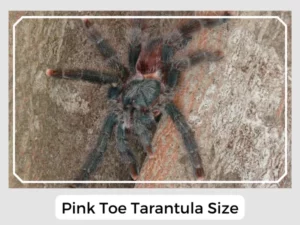The Pink-toed tarantula has many names like Guyana pinktoe and South American pinktoe. It’s a special spider from South America that loves daylight and climbing high. Unlike many tarantulas, you’ll find it hanging out on plants and trees. In this post, we’re going to share awesome facts about this tree-loving spider. Curious? Join us for a fun spider adventure!

The female pink toe spider makes its web soon after mating, in which it lays its 50 and 200 eggs that fertilize during the process of passing out of its body. As the eggs are laid, the mother wraps them into a ball, guarding the egg sac under its abdomen.
It takes about seven weeks for the eggs to hatch. In order to grow, the baby spiders need to pass through several molts, a process by which they shed the old exoskeleton, emerging in a fresh, larger one. During their first year, the young offspring molt five to six times during the first year.
Yes, Pink Toe Tarantulas have venom. They use it mostly to catch their bug snacks. But for humans, the venom is usually pretty mild.
Yes, Pink Toe Tarantulas can bite. They’re calm spiders, but if they get really scared or are handled a lot, they might give a bite.
The Pink Toe Tarantula, an arboreal spider in South American rainforests, controls pests, ensuring habitat health and diversity.
Natural Predator: Every creature has its nemesis, and for the Pink Toe Tarantula, the spider-wasp tops the list. These wasps are known to paralyze tarantulas and lay their eggs on them, providing their larvae with a fresh meal when they hatch. Aside from wasps, they are also hunted by hawks, owls, weasels, skunks, and snakes.
Prey-Predator Dynamics: As efficient predators, Pink Toe Tarantulas have perfected the art of stationization – remaining motionless until the right moment to pounce on unsuspecting prey. But life in the rainforest is always about balance. While they are adept hunters, they are also prey to many larger creatures.
Relationship with Humans: Humans, once fearful of these spiders, now appreciate and domesticate them. Their popularity as pets demands sustainable practices to protect wild populations.
| Lifespan | 4 to 8 years (males die within a few months from mating) |
| Distribution | In South America, starting from Costa Rica to Brazil, as well as in the southern parts of the Caribbean |
| Habitat | Dense plants and trees, cavities in the barks of dead trees |
| Common predators | The most common enemy is the spider-wasp; hawks, owls, weasels, skunks, and snakes also prey on these spiders |
| Diet | A wide variety of prey like grasshoppers, crickets, roaches, flying insects, and even small lizards and frogs |
In conclusion, the Pink Toe Tarantula exemplifies nature’s beauty and complexity. Their role in the ecosystem, their intricate dynamics with predators, and their growing bond with humans underline their importance in the web of life.
The Pink-toed tarantula has many names like Guyana pinktoe and South American pinktoe. It’s a special spider from South America that loves daylight and climbing high. Unlike many tarantulas, you’ll find it hanging out on plants and trees. In this post, we’re going to share awesome facts about this tree-loving spider. Curious? Join us for a fun spider adventure!

The female pink toe spider makes its web soon after mating, in which it lays its 50 and 200 eggs that fertilize during the process of passing out of its body. As the eggs are laid, the mother wraps them into a ball, guarding the egg sac under its abdomen.
It takes about seven weeks for the eggs to hatch. In order to grow, the baby spiders need to pass through several molts, a process by which they shed the old exoskeleton, emerging in a fresh, larger one. During their first year, the young offspring molt five to six times during the first year.
Yes, Pink Toe Tarantulas have venom. They use it mostly to catch their bug snacks. But for humans, the venom is usually pretty mild.
Yes, Pink Toe Tarantulas can bite. They’re calm spiders, but if they get really scared or are handled a lot, they might give a bite.
The Pink Toe Tarantula, an arboreal spider in South American rainforests, controls pests, ensuring habitat health and diversity.
Natural Predator: Every creature has its nemesis, and for the Pink Toe Tarantula, the spider-wasp tops the list. These wasps are known to paralyze tarantulas and lay their eggs on them, providing their larvae with a fresh meal when they hatch. Aside from wasps, they are also hunted by hawks, owls, weasels, skunks, and snakes.
Prey-Predator Dynamics: As efficient predators, Pink Toe Tarantulas have perfected the art of stationization – remaining motionless until the right moment to pounce on unsuspecting prey. But life in the rainforest is always about balance. While they are adept hunters, they are also prey to many larger creatures.
Relationship with Humans: Humans, once fearful of these spiders, now appreciate and domesticate them. Their popularity as pets demands sustainable practices to protect wild populations.
| Lifespan | 4 to 8 years (males die within a few months from mating) |
| Distribution | In South America, starting from Costa Rica to Brazil, as well as in the southern parts of the Caribbean |
| Habitat | Dense plants and trees, cavities in the barks of dead trees |
| Common predators | The most common enemy is the spider-wasp; hawks, owls, weasels, skunks, and snakes also prey on these spiders |
| Diet | A wide variety of prey like grasshoppers, crickets, roaches, flying insects, and even small lizards and frogs |
In conclusion, the Pink Toe Tarantula exemplifies nature’s beauty and complexity. Their role in the ecosystem, their intricate dynamics with predators, and their growing bond with humans underline their importance in the web of life.